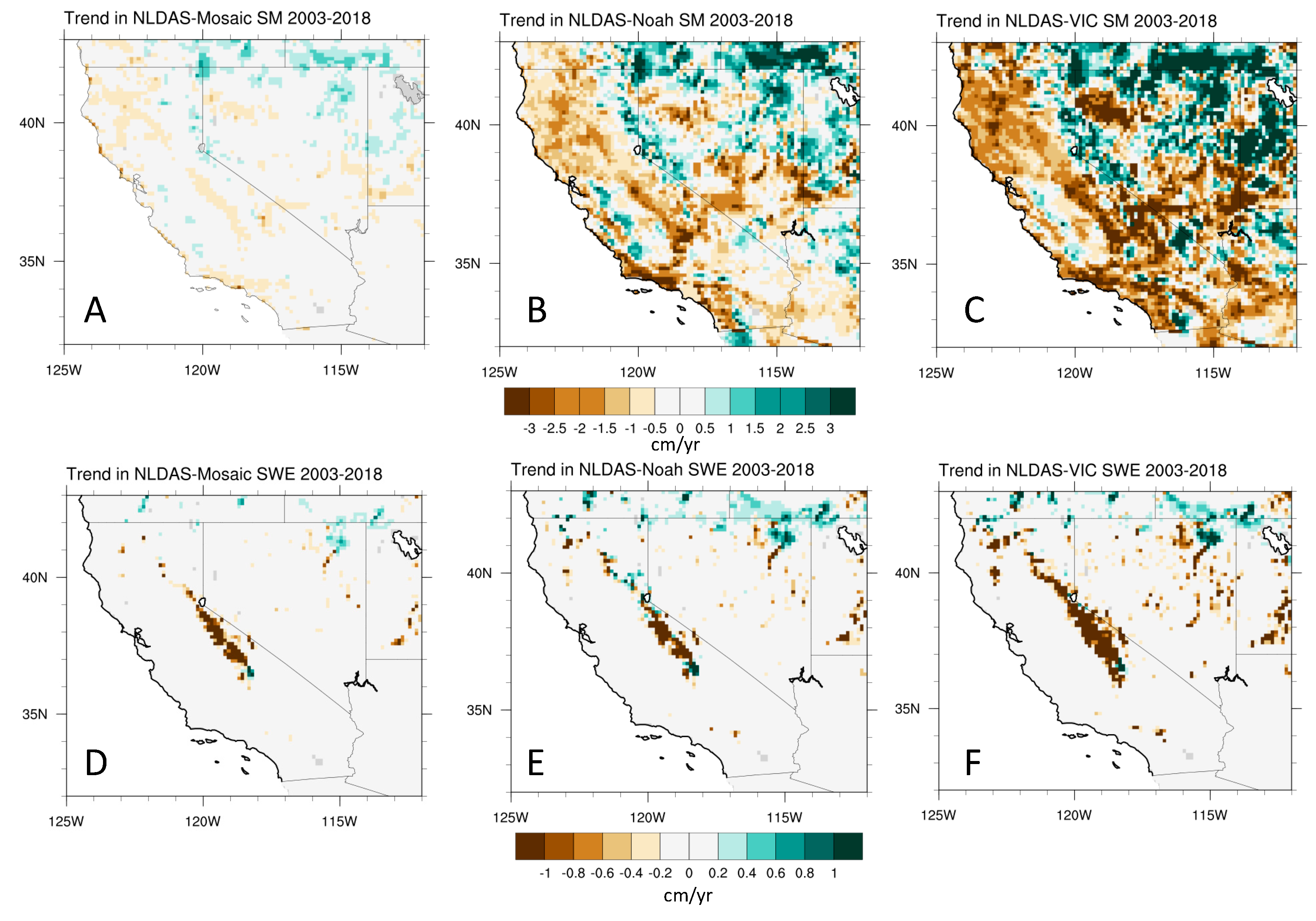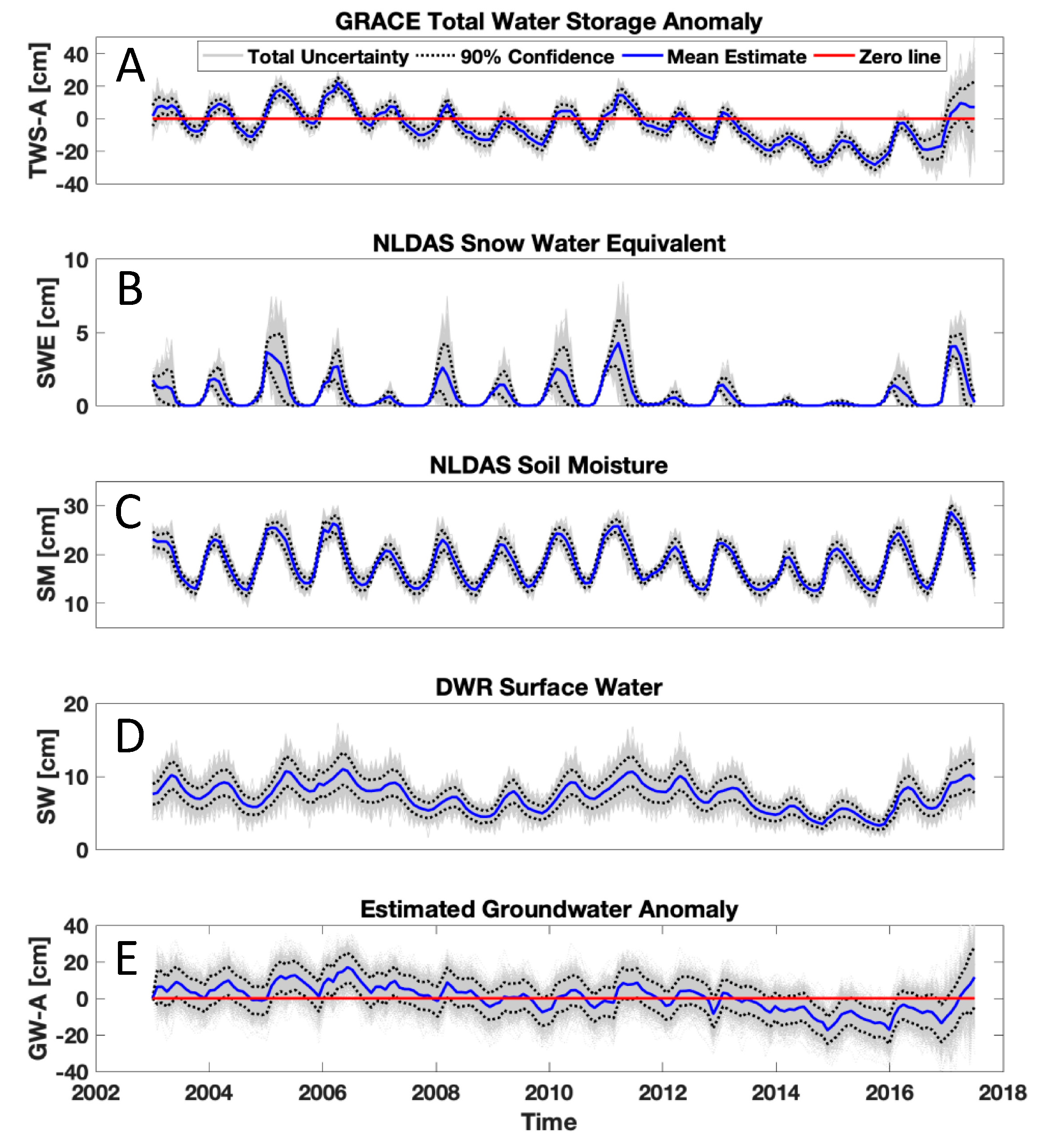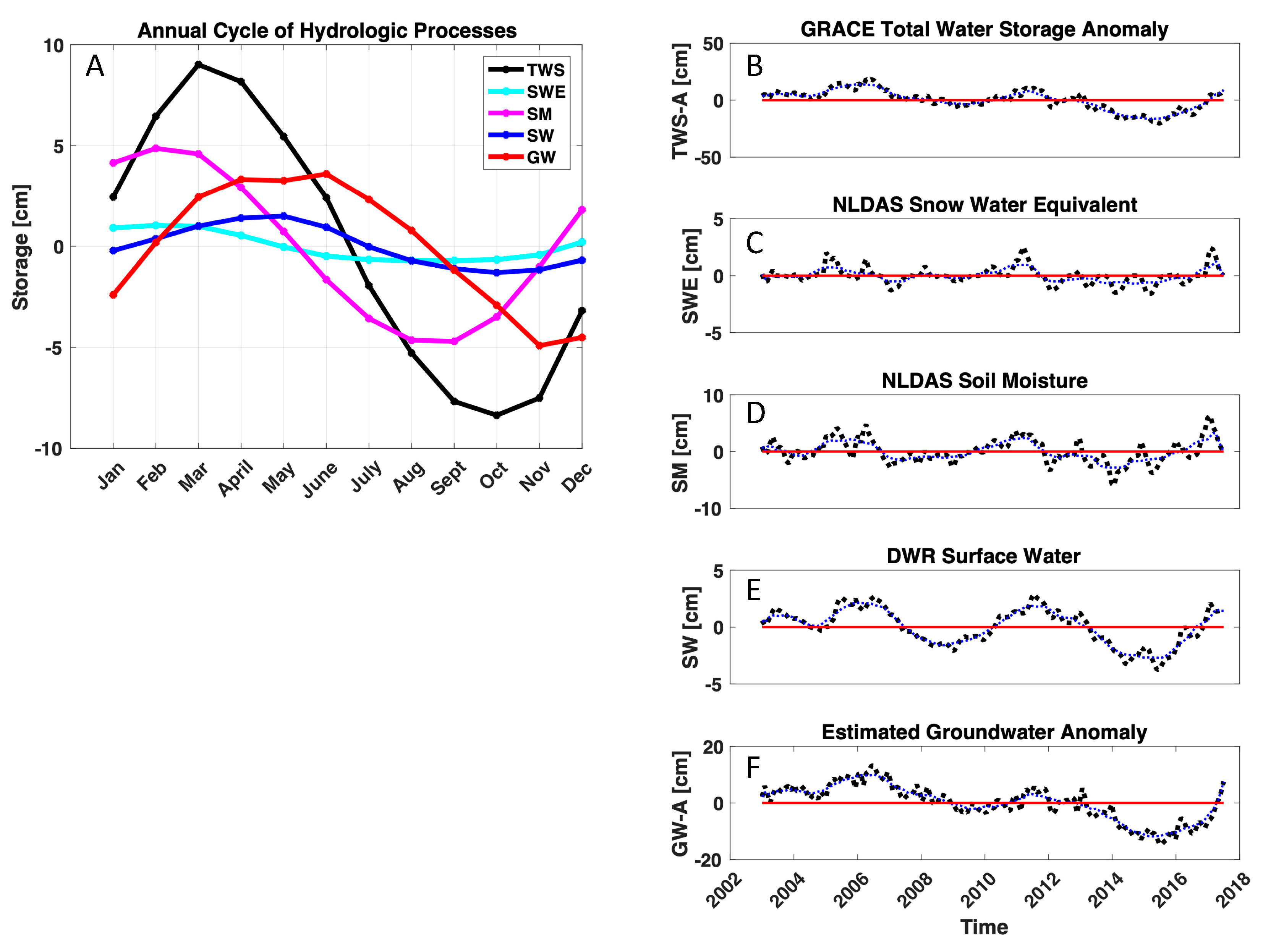Cascading Dynamics of the Hydrologic Cycle in California Explored through Observations and Model Simulations
Abstract
:1. Introduction
2. Data and Methods
2.1. GRACE Satellites
2.2. NLDAS—Mosaic, Noah, and VIC
2.3. Reservoir Data from the California DWR
2.4. Data Processing to Calculate Groundwater
2.5. Groundwater Estimates and Associated Uncertainties
2.6. Wavelet Analysis
3. Results
3.1. Trends in the Water Cycle
3.2. Cascading Effect of Hydrologic Cycle
3.3. Results from the Wavelet Analysis
4. Summary and Discussion
Author Contributions
Acknowledgments
Conflicts of Interest
References
- McCallum, A.M.; Andersen, M.S.; Giambastiani, B.M.; Kelly, B.F.; Ian Acworth, R. River–aquifer interactions in a semi-arid environment stressed by groundwater abstraction. Hydrol. Process. 2013, 27, 1072–1085. [Google Scholar] [CrossRef]
- Huang, J.P.; Ji, M.X.; Xie, Y.K.; Wang, S.S.; He, Y.L.; Ran, J.J. Global semi-arid climate change over last 60 years. Clim. Dyn. 2016, 46, 1131–1150. [Google Scholar] [CrossRef] [Green Version]
- Woodhouse, C.A.; Meko, D.M.; Macdonald, G.M.; Stahle, D.W.; Cook, E.R. A 1,200-year perspective of 21st century drought in southwestern North America. Proc. Natl. Acad. Sci. 2010, 107, 21283–21288. [Google Scholar] [CrossRef] [PubMed] [Green Version]
- McGuire, V. Water-Level Changes in the High Plains Aquifer, Predevelopment to 2007, 2005–06, and 2006–07; Scientific Investigations Report 2009-5019; U.S. Department of the Interior, U.S. Geological Survey: Reston, VA, USA, 2009.
- Rodell, M.; Velicogna, I.; Famiglietti, J.S. Satellite-based estimates of groundwater depletion in India. Nat. 2009, 460, 999–1002. [Google Scholar] [CrossRef] [Green Version]
- Wada, Y.; Van Beek, L.P.H.; Van Kempen, C.M.; Reckman, J.W.T.M.; Vasak, S.; Bierkens, M.F.P. Global depletion of groundwater resources. Geophys. Res. Lett. 2010, 37. [Google Scholar] [CrossRef] [Green Version]
- Famiglietti, J.S.; Lo, M.-H.; Ho, S.L.; Bethune, J.; Anderson, K.J.; Syed, T.H.; Swenson, S.C.; De Linage, C.R.; Rodell, M. Satellites measure recent rates of groundwater depletion in California’s Central Valley. Geophys. Res. Lett. 2011, 38. [Google Scholar] [CrossRef] [Green Version]
- Famiglietti, J.S. The global groundwater crisis. Nat. Clim. Chang. 2014, 4, 945–948. [Google Scholar] [CrossRef]
- Richey, A.S.; Thomas, B.F.; Lo, M.-H.; Reager, J.T.; Famiglietti, J.S.; Voss, K.; Swenson, S.; Rodell, M. Quantifying renewable groundwater stress with GRACE. Water Resour. Res. 2015, 51, 5217–5238. [Google Scholar] [CrossRef]
- Shang, H.; Wang, W.; Dai, Z.; Duan, L.; Zhao, Y.; Zhang, J. An ecology-oriented exploitation mode of groundwater resources in the northern Tianshan Mountains, China. J. Hydrol. 2016, 543, 386–394. [Google Scholar] [CrossRef]
- Massoud, E.C.; Purdy, A.J.; Miro, M.E.; Famiglietti, J.S. Projecting groundwater storage changes in California’s Central Valley. Sci. Rep. 2018, 8, 12917. [Google Scholar] [CrossRef]
- Liu, Z.; Liu, P.-W.; Massoud, E.; Farr, T.G.; Lundgren, P.; Famiglietti, J.S. Monitoring Groundwater Change in California’s Central Valley Using Sentinel-1 and GRACE Observations. Geosciences 2019, 9, 436. [Google Scholar] [CrossRef] [Green Version]
- Scanlon, B.R.; Longuevergne, L.; Long, D. Ground referencing GRACE satellite estimates of groundwater storage changes in the California Central Valley, US. Wat. Resour. Res. 2012, 48, W04520. [Google Scholar] [CrossRef] [Green Version]
- Harbaugh, A.W.; Banta, E.R.; Hill, M.C.; McDonald, M.G. MODFLOW-2000, The U.S. Geological Survey Modular Ground-Water Model-User Guide to Modularization Concepts and the Ground-Water Flow Process; Open-File Report 00-92; U.S. Geological Survey: Reston, VA, USA, 2000.
- Margulis, S.A.; Cortés, G.; Girotto, M.; Durand, M. A Landsat-era Sierra Nevada snow reanalysis (1985–2015). J. Hydrometeorol. 2016, 17, 1203–1221. [Google Scholar] [CrossRef]
- Yang, Z.-L.; Niu, G.-Y.; Mitchell, K.E.; Chen, F.; Ek, M.B.; Barlage, M.; Longuevergne, L.; Manning, K.; Niyogi, D.; Tewari, M.; et al. The community Noah land surface model with multiparameterization options (Noah-MP): 2. Evaluation over global river basins. J. Geophys. Res. Space Phys. 2011, 116, D12110. [Google Scholar] [CrossRef]
- He, X.; Wada, Y.; Wanders, N.; Sheffield, J. Intensification of hydrological drought in California by human water management. Geophys. Res. Lett. 2017, 44, 1777–1785. [Google Scholar] [CrossRef] [Green Version]
- Zaitchik, B.F.; Rodell, M.; Reichle, R.H. Assimilation of GRACE Terrestrial Water Storage Data into a Land Surface Model: Results for the Mississippi River Basin. J. Hydrometeorol. 2008, 9, 535–548. [Google Scholar] [CrossRef]
- Xia, Y.; Mitchell, K.; Ek, M.; Cosgrove, B.; Sheffield, J.; Luo, L.; Alonge, C.; Wei, H.; Meng, J.; Livneh, B.; et al. Continental-scale water and energy flux analysis and validation for North American Land Data Assimilation System project phase 2 (NLDAS-2): 2. Validation of model-simulated streamflow. J. Geophys. Res. 2012, 117, D03109. [Google Scholar] [CrossRef]
- Lo, M.-H.; Famiglietti, J.S. Irrigation in California’s central valley strengthens the southwestern us water cycle. Geophys. Res. Lett. 2013, 40, 301–306. [Google Scholar] [CrossRef] [Green Version]
- Faunt, C.C.; Hanson, R.; Belitz, K. Groundwater Availability of the Central Valley Aquifer, California; Professional Paper 1766; U.S. Geological Survey: Reston, VA, USA, 2009.
- Dong, L.; Wang, W.; Ma, M.; Kong, J.; Veroustraete, F. The change of land cover and land use and its impact factors in upriver key regions of the Yellow River. Int. J. Remote. Sens. 2009, 30, 1251–1265. [Google Scholar] [CrossRef]
- Siebert, S.; Burke, J.; Faures, J.M.; Frenken, K.; Hoogeveen, J.; Döll, P.; Portmann, F.T. Groundwater use for irrigation–a global inventory. Hydrol. Earth Syst. Sci. 2010, 14, 1863–1880. [Google Scholar] [CrossRef] [Green Version]
- Lund, J.; Medellin-Azuara, J.; Durand, J.; Stone, K. Lessons from California’s 2012–2016 drought. J. Water Resour. Plan. Manag. 2018, 144, 04018067. [Google Scholar] [CrossRef] [Green Version]
- Alley, W.M. Flow and Storage in Groundwater Systems. Science 2002, 296, 1985–1990. [Google Scholar] [CrossRef] [Green Version]
- Yeh, P.J.-F.; Swenson, S.C.; Famiglietti, J.S.; Rodell, M. Remote sensing of groundwater storage changes in Illinois using the Gravity Recovery and Climate Experiment (GRACE). Water Resour. Res. 2006, 42. [Google Scholar] [CrossRef]
- Purdy, A.J.; David, C.H.; Sikder, S.; Reager, J.T.; Chandanpurkar, H.A.; Jones, N.L.; Matin, M.A. An Open-Source Tool to Facilitate the Processing of GRACE Observations and GLDAS Outputs: An Evaluation in Bangladesh. Front. Environ. Sci. 2019, 7, 155. [Google Scholar] [CrossRef]
- Tapley, B.D.; Bettadpur, S.; Ries, J.C.; Thompson, P.F.; Watkins, M.M. GRACE Measurements of Mass Variability in the Earth System. Science 2004, 305, 503–505. [Google Scholar] [CrossRef] [Green Version]
- Reager, J.T.; Thomas, A.C.; Sproles, E.A.; Rodell, M.; Beaudoing, H.K.; Li, B.; Famiglietti, J.S. Assimilation of GRACE Terrestrial Water Storage Observations into a Land Surface Model for the Assessment of Regional Flood Potential. Remote. Sens. 2015, 7, 14663–14679. [Google Scholar] [CrossRef] [Green Version]
- Xiao, M.; Koppa, A.; Mekonnen, Z.; Pagán, B.R.; Zhan, S.; Cao, Q.; Aierken, A.; Lee, H.; Lettenmaier, D.P. How much groundwater did California’s Central Valley lose during the 2012– 2016 drought? Geophys. Res. Lett. 2017, 44, 4872–4879. [Google Scholar] [CrossRef]
- Mitchell, K.E.; Lohmann, D.; Houser, P.R.; Wood, E.F.; Schaake, J.C.; Robock, A.; Cosgrove, B.A.; Sheffield, J.; Duan, Q.; Luo, L.; et al. The multi-institution North American Land Data Assimilation System (NLDAS): Utilizing multiple GCIP products and partners in a continental distributed hydrological modeling system. J. Geophys. Res. Space Phys. 2004, 109. [Google Scholar] [CrossRef] [Green Version]
- Tiwari, V.M.; Wahr, J.; Swenson, S. Dwindling groundwater resources in northern India, from satellite gravity observations. Geophys. Res. Lett. 2009, 36, 18401. [Google Scholar] [CrossRef] [Green Version]
- Voss, K.A.; Famiglietti, J.S.; Lo, M.-H.; Linage, C.; Rodell, M.; Swenson, S.C. Groundwater depletion in the Middle East from GRACE with implications for transboundary water management in the Tigris-Euphrates-Western Iran region. Water Resour. Res. 2013, 49, 904–914. [Google Scholar] [CrossRef] [Green Version]
- Forootan, E.; Rietbroek, R.; Kusche, J.; Sharifi, M.; Awange, J.; Schmidt, M.; Omondi, P.; Famiglietti, J. Separation of large scale water storage patterns over Iran using GRACE, altimetry and hydrological data. Remote. Sens. Environ. 2014, 140, 580–595. [Google Scholar] [CrossRef] [Green Version]
- Moiwo, J.; Yang, Y.; Li, H.; Han, S.; Hu, Y. Comparison of GRACE with in situ hydrological measurement data shows storage depletion in Hai River basin, Northern China. Water SA 2009, 35, 663–670. [Google Scholar] [CrossRef] [Green Version]
- Feng, W.; Zhong, M.; Lemoine, J.M.; Biancale, R.; Hsu, H.T.; Xia, J. Evaluation of groundwater depletion in North China using the Gravity Recovery and Climate Experiment (GRACE) data and ground-based measurements. Water Resour. Res. 2013, 49, 2110–2118. [Google Scholar] [CrossRef]
- Watkins, M.M.; Wiese, D.N.; Yuan, D.-N.; Boening, C.; Landerer, F.W. Improved methods for observing Earth’s time variable mass distribution with GRACE using spherical cap mascons. J. Geophys. Res. Solid Earth 2015, 120, 2648–2671. [Google Scholar] [CrossRef]
- Wiese, D.N.; Yuan, D.-N.; Boening, C.; Landerer, F.W.; Watkins, M.M. JPL GRACE Mascon Ocean, Ice, and Hydrology Equivalent Water Height RL05M.1 CRI Filtered Version 2, PO.DAAC, CA, USA. Available online: http://dx.doi.org/10.5067/TEMSC-2LCR5 (accessed on 1 October 2018).
- Foufoula-Georgiou, E.; Kumar, P.; Mukerji, T.; Mavko, G. Wavelets in geophysics. Pure Appl. Geophys. 1995, 145, 374–375. [Google Scholar]
- Grinsted, A.; Moore, J.C.; Jevrejeva, S. Application of the cross wavelet transform and wavelet coherence to geophysical time series. Nonlinear Process. Geophys. 2004, 11, 561566. [Google Scholar] [CrossRef]






| Entire Record | 2003−2017 | ||
| Storage Compartment | Trend (cm/yr) | Volume Trend (km3/yr) | Volume Lost (km3) |
| Total | −1.36 ± 0.15 | −3.98 ± 0.43 | −55.69 |
| Soil Water | −0.05 ± 0.04 | −0.15 ± 0.12 | −2.11 |
| Snow Water | −0.02 ± 0.02 | −0.06 ± 0.05 | −0.80 |
| Reservoir | −0.15 ± 0.04 | −0.44 ± 0.12 | −6.17 |
| Groundwater | −1.14 ± 0.16 | −3.33 ± 0.46 | −46.60 |
| Drought 1 | 2006–2010 | ||
| Storage Compartment | Trend (cm/yr) | Volume Trend (km3/yr) | Volume Lost (km3) |
| Total | −6.37 ± 0.67 | −18.60 ± 1.97 | −74.40 |
| Soil Water | −1.00 ± 0.28 | −2.91 ± 0.81 | −11.64 |
| Snow Water | −0.13 ± 0.09 | −0.39 ± 0.27 | −1.55 |
| Reservoir | −1.19 ± 0.29 | −3.48 ± 0.85 | −13.92 |
| Groundwater | −4.05 ± 0.81 | −11.82 ± 2.36 | −47.29 |
| Drought 2 | 2012−2016 | ||
| Storage Compartment | Trend (cm/yr) | Volume Trend (km3/yr) | Volume Lost (km3) |
| Total | −6.28 ± 0.65 | −18.35 ± 1.89 | −73.41 |
| Soil Water | −0.49 ± 0.25 | −1.42 ± 0.72 | −5.70 |
| Snow Water | −0.06 ± 0.04 | −0.18 ± 0.12 | −0.72 |
| Reservoir | −1.37 ± 0.25 | −4.00 ± 0.72 | −15.99 |
| Groundwater | −4.37 ± 0.74 | −12.75 ± 2.15 | −51.01 |
| 2006−2010 Drought | SM | SWE | SW | GW | TWS |
| Begin Drought 1 | 2006.8 | 2006.6 | 2007.5 | 2008.9 | 2008.4 |
| Peak Drought 1 | 2007.4 | 2007.4 | 2008.7 | 2009.5 | 2009.5 |
| End Drought 1 | 2009.7 | 2009.7 | 2010.3 | 2010.8 | 2010.4 |
| Minimum (km3) | −4.62 | −1.46 | −4.62 | −6.28 | −11.16 |
| 2012−2016 Drought | SM | SWE | SW | GW | TWS |
| Begin Drought 2 | 2011.9 | 2011.8 | 2013.2 | 2012.9 | 2012.8 |
| Peak Drought 2 | 2014 | 2014.7 | 2015.5 | 2015.2 | 2015.2 |
| End Drought 2 | 2016.2 | 2016.6 | 2016.7 | 2017.3 | 2017.1 |
| Minimum (km3) | −8.30 | −2.02 | −7.89 | −34.73 | −48.23 |
© 2020 by the authors. Licensee MDPI, Basel, Switzerland. This article is an open access article distributed under the terms and conditions of the Creative Commons Attribution (CC BY) license (http://creativecommons.org/licenses/by/4.0/).
Share and Cite
Massoud, E.; Turmon, M.; Reager, J.; Hobbs, J.; Liu, Z.; David, C.H. Cascading Dynamics of the Hydrologic Cycle in California Explored through Observations and Model Simulations. Geosciences 2020, 10, 71. https://doi.org/10.3390/geosciences10020071
Massoud E, Turmon M, Reager J, Hobbs J, Liu Z, David CH. Cascading Dynamics of the Hydrologic Cycle in California Explored through Observations and Model Simulations. Geosciences. 2020; 10(2):71. https://doi.org/10.3390/geosciences10020071
Chicago/Turabian StyleMassoud, Elias, Michael Turmon, John Reager, Jonathan Hobbs, Zhen Liu, and Cédric H. David. 2020. "Cascading Dynamics of the Hydrologic Cycle in California Explored through Observations and Model Simulations" Geosciences 10, no. 2: 71. https://doi.org/10.3390/geosciences10020071





